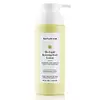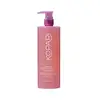What's inside
What's inside
 Key Ingredients
Key Ingredients

 Benefits
Benefits

 Concerns
Concerns

 Ingredients Side-by-side
Ingredients Side-by-side

Water
Skin ConditioningCarthamus Tinctorius Seed Oil
MaskingCetyl Alcohol
EmollientGlycerin
HumectantCaprylic/Capric Triglyceride
MaskingButyrospermum Parkii Butter
Skin ConditioningDimethicone
EmollientC10-18 Triglycerides
EmollientMoringa Oleifera Seed Oil
EmollientNiacinamide
SmoothingRosa Canina Fruit Oil
EmollientPanthenol
Skin ConditioningSodium PCA
HumectantSodium Stearoyl Glutamate
CleansingSqualane
EmollientVaccinium Myrtillus Fruit Extract
Skin ConditioningSaccharum Officinarum Extract
MoisturisingRiboflavin
Cosmetic ColorantTocopherol
AntioxidantCitrus Aurantium Dulcis Fruit Extract
MaskingCitrus Limon Fruit Extract
MaskingSodium Glycolate
BufferingCamellia Sinensis Leaf Extract
AntimicrobialSpilanthes Acmella Flower Extract
Skin ConditioningSodium Formate
BufferingAcer Saccharum Extract
Skin ConditioningSodium Hyaluronate
HumectantCetearyl Olivate
Sorbitan Olivate
EmulsifyingPhenoxyethanol
PreservativeCarbomer
Emulsion StabilisingTocopheryl Acetate
AntioxidantEthylhexylglycerin
Skin ConditioningSodium Hydroxide
BufferingTetrasodium Glutamate Diacetate
Citric Acid
BufferingPotassium Sorbate
PreservativeSodium Benzoate
MaskingWater, Carthamus Tinctorius Seed Oil, Cetyl Alcohol, Glycerin, Caprylic/Capric Triglyceride, Butyrospermum Parkii Butter, Dimethicone, C10-18 Triglycerides, Moringa Oleifera Seed Oil, Niacinamide, Rosa Canina Fruit Oil, Panthenol, Sodium PCA, Sodium Stearoyl Glutamate, Squalane, Vaccinium Myrtillus Fruit Extract, Saccharum Officinarum Extract, Riboflavin, Tocopherol, Citrus Aurantium Dulcis Fruit Extract, Citrus Limon Fruit Extract, Sodium Glycolate, Camellia Sinensis Leaf Extract, Spilanthes Acmella Flower Extract, Sodium Formate, Acer Saccharum Extract, Sodium Hyaluronate, Cetearyl Olivate, Sorbitan Olivate, Phenoxyethanol, Carbomer, Tocopheryl Acetate, Ethylhexylglycerin, Sodium Hydroxide, Tetrasodium Glutamate Diacetate, Citric Acid, Potassium Sorbate, Sodium Benzoate
Water
Skin ConditioningSodium C14-16 Olefin Sulfonate
CleansingAloe Barbadensis Leaf Juice
Skin ConditioningGlycerin
HumectantCocamidopropyl Betaine
CleansingCocamidopropyl Hydroxysultaine
CleansingSodium Methyl Cocoyl Taurate
CleansingPhenoxyethanol
PreservativeSodium Benzoate
MaskingParfum
MaskingCocos Nucifera Water
MaskingPolyquaternium-7
Chlorphenesin
AntimicrobialCitric Acid
BufferingGuar Hydroxypropyltrimonium Chloride
Skin ConditioningDecyl Glucoside
CleansingAlgae Extract
EmollientArgania Spinosa Kernel Oil
EmollientGluconolactone
Skin ConditioningWater, Sodium C14-16 Olefin Sulfonate, Aloe Barbadensis Leaf Juice, Glycerin, Cocamidopropyl Betaine, Cocamidopropyl Hydroxysultaine, Sodium Methyl Cocoyl Taurate, Phenoxyethanol, Sodium Benzoate, Parfum, Cocos Nucifera Water, Polyquaternium-7, Chlorphenesin, Citric Acid, Guar Hydroxypropyltrimonium Chloride, Decyl Glucoside, Algae Extract, Argania Spinosa Kernel Oil, Gluconolactone
 Reviews
Reviews

Ingredients Explained
These ingredients are found in both products.
Ingredients higher up in an ingredient list are typically present in a larger amount.
Citric Acid is an alpha hydroxy acid (AHA) naturally found in citrus fruits like oranges, lemons, and limes.
Like other AHAs, citric acid can exfoliate skin by breaking down the bonds that hold dead skin cells together. This helps reveal smoother and brighter skin underneath.
However, this exfoliating effect only happens at high concentrations (20%) which can be hard to find in cosmetic products.
Due to this, citric acid is usually included in small amounts as a pH adjuster. This helps keep products slightly more acidic and compatible with skin's natural pH.
In skincare formulas, citric acid can:
While it can provide some skin benefits, research shows lactic acid and glycolic acid are generally more effective and less irritating exfoliants.
Most citric acid used in skincare today is made by fermenting sugars (usually from molasses). This synthetic version is identical to the natural citrus form but easier to stabilize and use in formulations.
Read more about some other popular AHA's here:
Learn more about Citric AcidGlycerin is already naturally found in your skin. It helps moisturize and protect your skin.
A study from 2016 found glycerin to be more effective as a humectant than AHAs and hyaluronic acid.
As a humectant, it helps the skin stay hydrated by pulling moisture to your skin. The low molecular weight of glycerin allows it to pull moisture into the deeper layers of your skin.
Hydrated skin improves your skin barrier; Your skin barrier helps protect against irritants and bacteria.
Glycerin has also been found to have antimicrobial and antiviral properties. Due to these properties, glycerin is often used in wound and burn treatments.
In cosmetics, glycerin is usually derived from plants such as soybean or palm. However, it can also be sourced from animals, such as tallow or animal fat.
This ingredient is organic, colorless, odorless, and non-toxic.
Glycerin is the name for this ingredient in American English. British English uses Glycerol/Glycerine.
Learn more about GlycerinPhenoxyethanol is a preservative that has germicide, antimicrobial, and aromatic properties. Studies show that phenoxyethanol can prevent microbial growth. By itself, it has a scent that is similar to that of a rose.
It's often used in formulations along with Caprylyl Glycol to preserve the shelf life of products.
Sodium Benzoate is a preservative. It's used in both cosmetic and food products to inhibit the growth of mold and bacteria. It is typically produced synthetically.
Both the US FDA and EU Health Committee have approved the use of sodium benzoate. In the US, levels of 0.1% (of the total product) are allowed.
Sodium benzoate works as a preservative by inhibiting the growth of bacteria inside of cells. It prevents the cell from fermenting a type of sugar using an enzyme called phosphofructokinase.
It is the salt of benzoic acid. Foods containing sodium benzoate include soda, salad dressings, condiments, fruit juices, wines, and snack foods.
Studies for using ascorbic acid and sodium benzoate in cosmetics are lacking, especially in skincare routines with multiple steps.
We always recommend speaking with a professional, such as a dermatologist, if you have any concerns.
Learn more about Sodium BenzoateWater. It's the most common cosmetic ingredient of all. You'll usually see it at the top of ingredient lists, meaning that it makes up the largest part of the product.
So why is it so popular? Water most often acts as a solvent - this means that it helps dissolve other ingredients into the formulation.
You'll also recognize water as that liquid we all need to stay alive. If you see this, drink a glass of water. Stay hydrated!
Learn more about Water